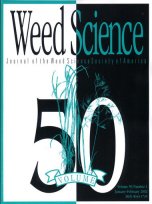Studies were conducted to evaluate weed management programs in nontransgenic, bromoxynil-resistant, and glyphosate-resistant cotton in nontilled and tilled environments. Tillage did not affect weed control provided by herbicides. Early-season stunting in nontilled cotton was 3% regardless of the herbicide system and was no longer evident at midseason. Cotton yield was 10 to 15% greater, on an average, under tilled conditions than that under nontilled conditions. Excellent (> 90%) common lambsquarters, entireleaf morningglory, ivyleaf morningglory, jimsonweed, pitted morningglory, prickly sida, tall morningglory, and velvetleaf control was achieved with treatments containing pyrithiobac, bromoxynil, and glyphosate. Preemergence (PRE) or postemergence-directed (PD) herbicide inputs were necessary for adequate large crabgrass and goosegrass control. Bromoxynil and pyrithiobac postemergence did not control sicklepod unless supplemented with MSMA and followed by a late-postdirected treatment of cyanazine plus MSMA. Treatments that included glyphosate controlled sicklepod regardless of the late-PD treatment. Economic returns were at least $930 ha−1 and not different from the higher yielding programs in nontransgenic cotton when fluometuron applied PRE was included in the bromoxynil programs. Late-season weed control was usually greater than 90% from glyphosate programs, and net returns from glyphosate programs were as high or higher than the net returns from programs that used midseason treatments of bromoxynil, pyrithiobac, or fluometuron plus MSMA.
Nomenclature: Bromoxynil; cyanazine; fluometuron; glyphosate; MSMA; pendimethalin; pyrithiobac; common lambsquarters, Chenopodium album L. CHEAL; entireleaf morningglory, Ipomoea hederacea var. integriuscula Gray IPOHG; goosegrass, Eleusine indica (L.) Gaertn. ELEIN; ivyleaf morningglory, Ipomoea hederacea (L.) Jacq. IPOHE; jimsonweed, Datura stramonium L. DATST; large crabgrass, Digitaria sanguinalis (L.) Scop. DIGSA; pitted morningglory, Ipomoea lacunosa L. IPOLA; prickly sida, Sida spinosa L. SIDSP; sicklepod, Senna obtusifolia (L.) Irwin and Barnaby CASOB; smooth pigweed, Amaranthus hybridus L. AMACH; tall morningglory, Ipomoea purpurea L. PHBPU; velvetleaf, Abutilon theophrasti Medicus ABUTH; cotton, Gossypium hirsutum L. ‘Paymaster 1330RR’, ‘Stoneville BXN47’, ‘Stoneville 474’.





